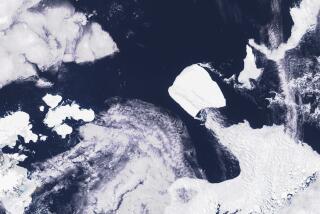Antarctic ice streams wedged in
A vast undersea wedge of gravel and grit holds the ice streams of West Antarctica in place like a doorstop, even as rising seas caused by global warming threaten to undermine them, researchers at Pennsylvania State University said Thursday.
The discovery may give the world a bit of breathing room.
West Antarctica encompasses enough frozen fresh water -- 7 million cubic miles -- to raise sea levels worldwide 16 feet if its ice sheet disintegrates. All told, Antarctica holds 90% of the world’s ice.
A new radar survey of part of West Antarctica, reported in the journal Science, revealed a submerged bluff of glacial till miles long and 100 feet thick along the seabed at the point, called the grounding line, where the ice begins to float out over the water of the Ross Sea.
The ridge effectively stabilizes the ice against the rising water, the Penn State scientists reported.
“Small sea level changes don’t kick the ice sheet very much,” said Penn State geoscientist Richard Alley, author of a related study in Science.
Computer simulations designed by Alley and his colleagues suggest that it would take a sea level rise of more than 33 feet to dislodge the ice stream and trigger a major collapse.
Still, Penn State geoscientist Sridhar Anandakrishnan, who conducted the survey during two six-week field seasons in 2004 and 2005, cautioned: “I am not saying these glaciers will sit there forever and not respond to sea level.... If you raise it fast enough and high enough, a whole bunch of it will go at once.”
Uncertainty over the fate of Antarctica’s ice has been the biggest unknown in predicting future sea levels as rising temperatures alter the global climate.
Last month, United Nations climate experts reported that by the end of the century, oceans could rise 7 to 23 inches, high enough to inundate low-lying areas around the world that are home to millions of people.
While the ice sheets of Greenland are deteriorating twice as fast as they were five years ago, the behavior of the ice cap at the southern end of the world has defied easy explanation.
After a century of steadily rising temperatures worldwide, Antarctica is a continent of contradictions. It is warming in some regions but cooling in other areas. The ice along its coastal edges is thinning, but the frozen crust of its heartland is thickening with new snow every year.
The radar survey focused on West Antarctica’s Whillans ice stream, one of many flowing from Antarctica’s interior to the sea. It is 1,900 feet thick and 310 miles long.
The ice stream, moving at a speed of about 400 meters a year, has been building its own sea wall for centuries, grinding up the bedrock underneath it, dragging the grit along and then dumping it on the sea floor.
The ice stream pushes debris along its leading edge, like a pig snuffling up mud with its snout, building a foundation that thwarts the typical process of ice sheet deterioration.
“This is why Antarctica is not going in lock step with what is happening in the Northern Hemisphere as sea level rises,” Anandakrishnan said. “You go up and down the sea coast and all these glaciers have this jacked-up grounding line.”
In a sense, the new finding is a measure of how much researchers have yet to learn about a remote continent of ice miles thick that is still responding to the end of the last Ice Age about 10,000 years ago.
To that end, on Thursday scientists formally launched the largest polar research program in 50 years. The effort, conducted under the banner of the International Polar Year, encompasses 50,000 scientists in 60 countries working on 220 projects aimed at understanding the role of the polar regions in climate change.
“Every time we look at the ice sheet, we find something new,” Alley said. “Understanding these mysteries will be necessary to predict the behavior of the great ice sheet in a warming world.”






